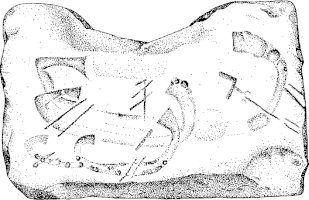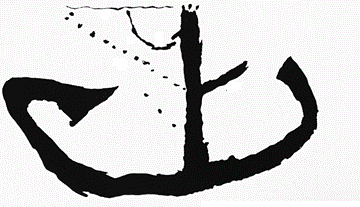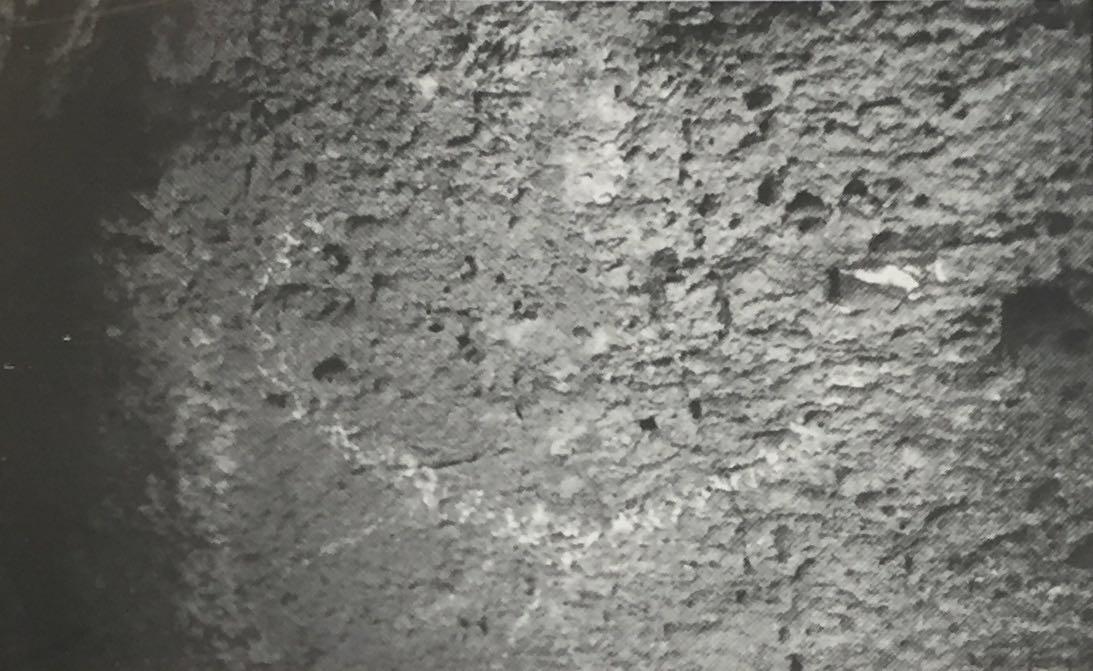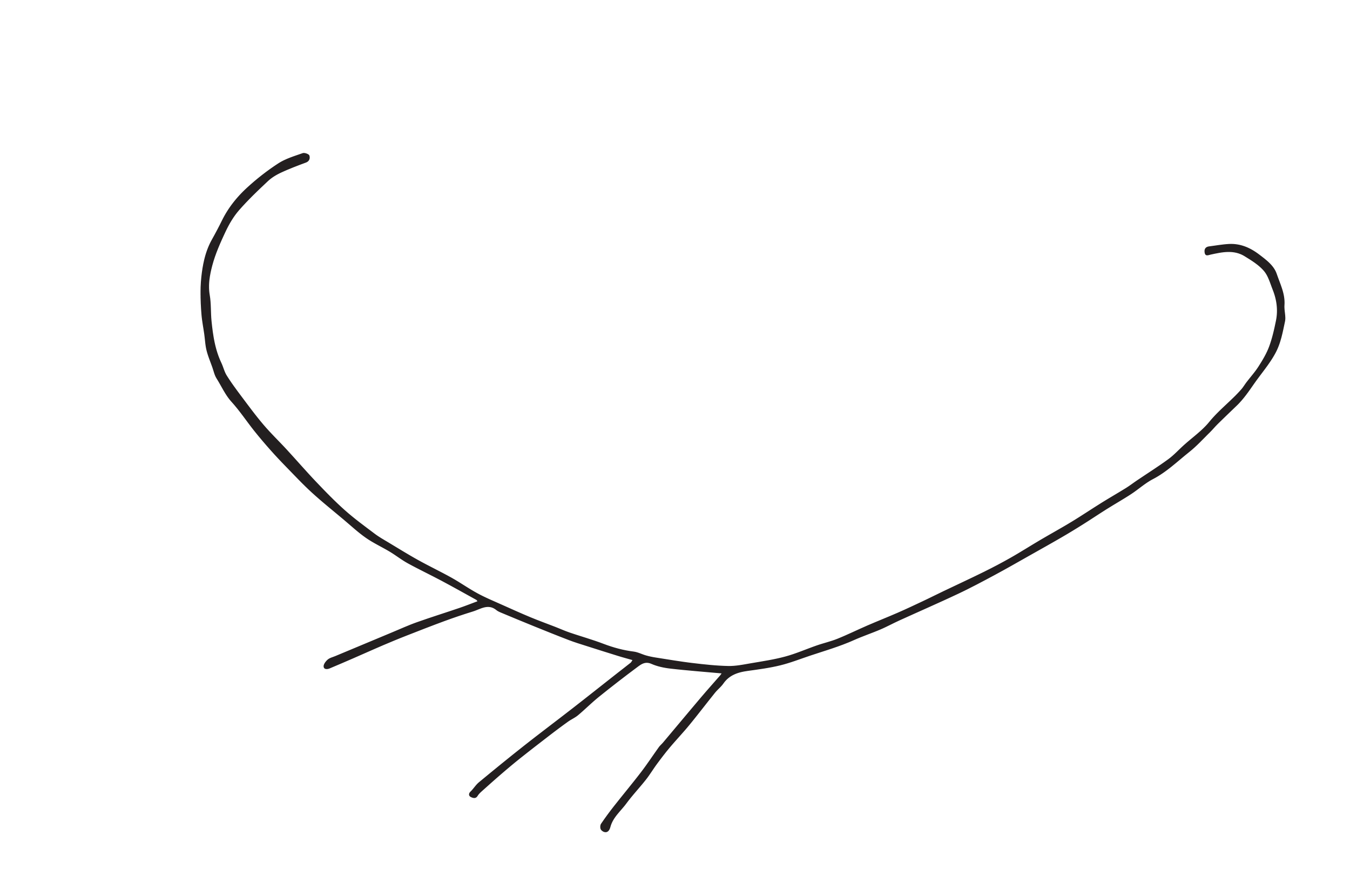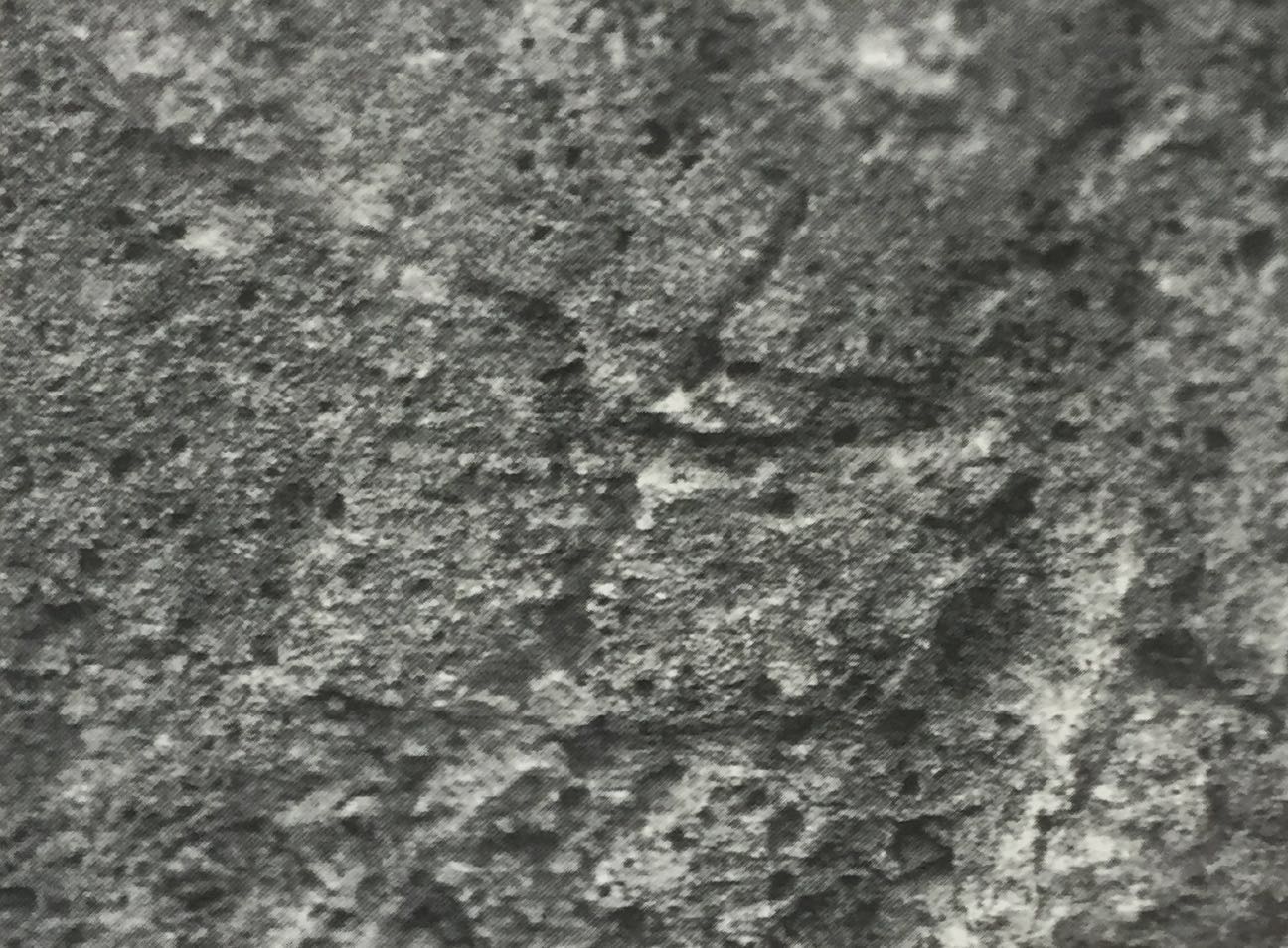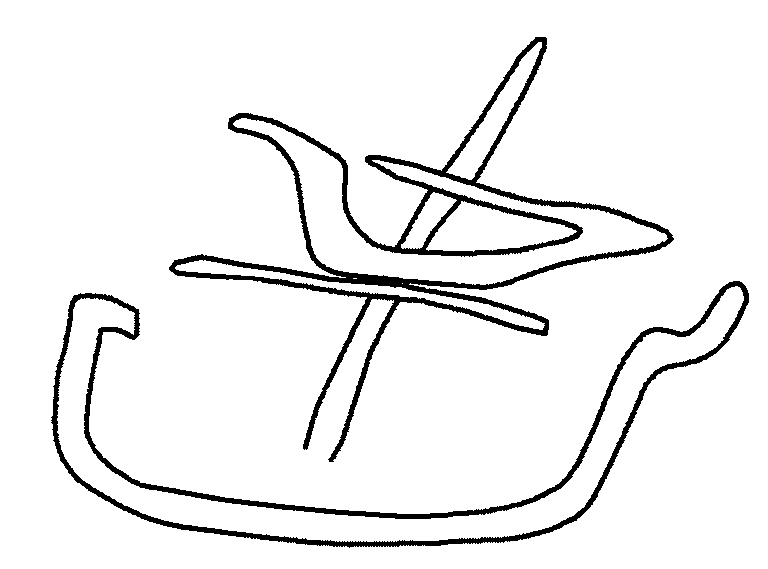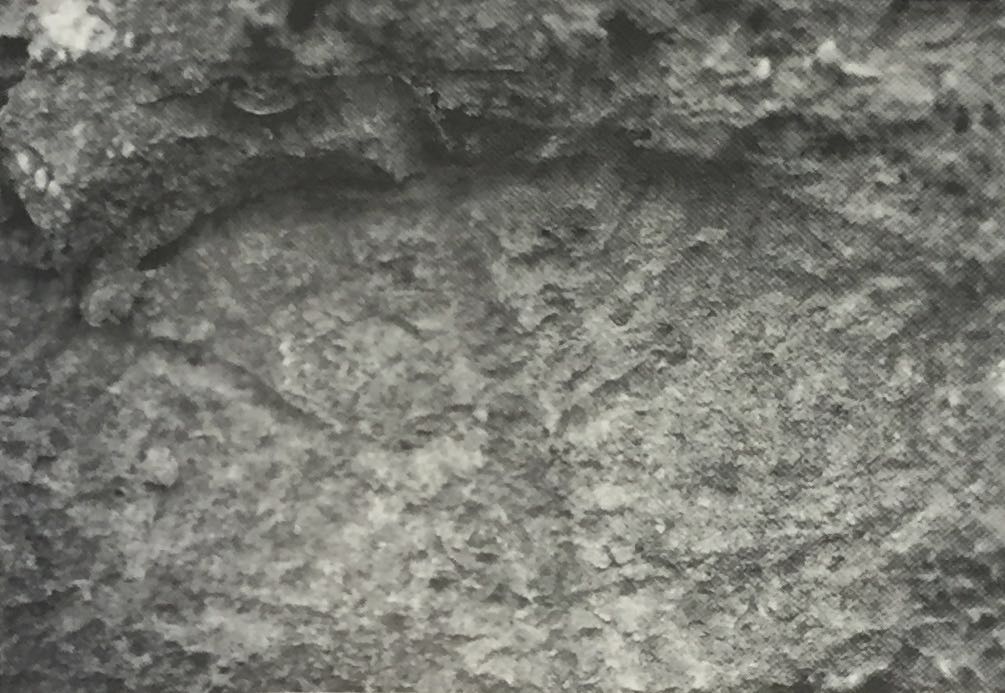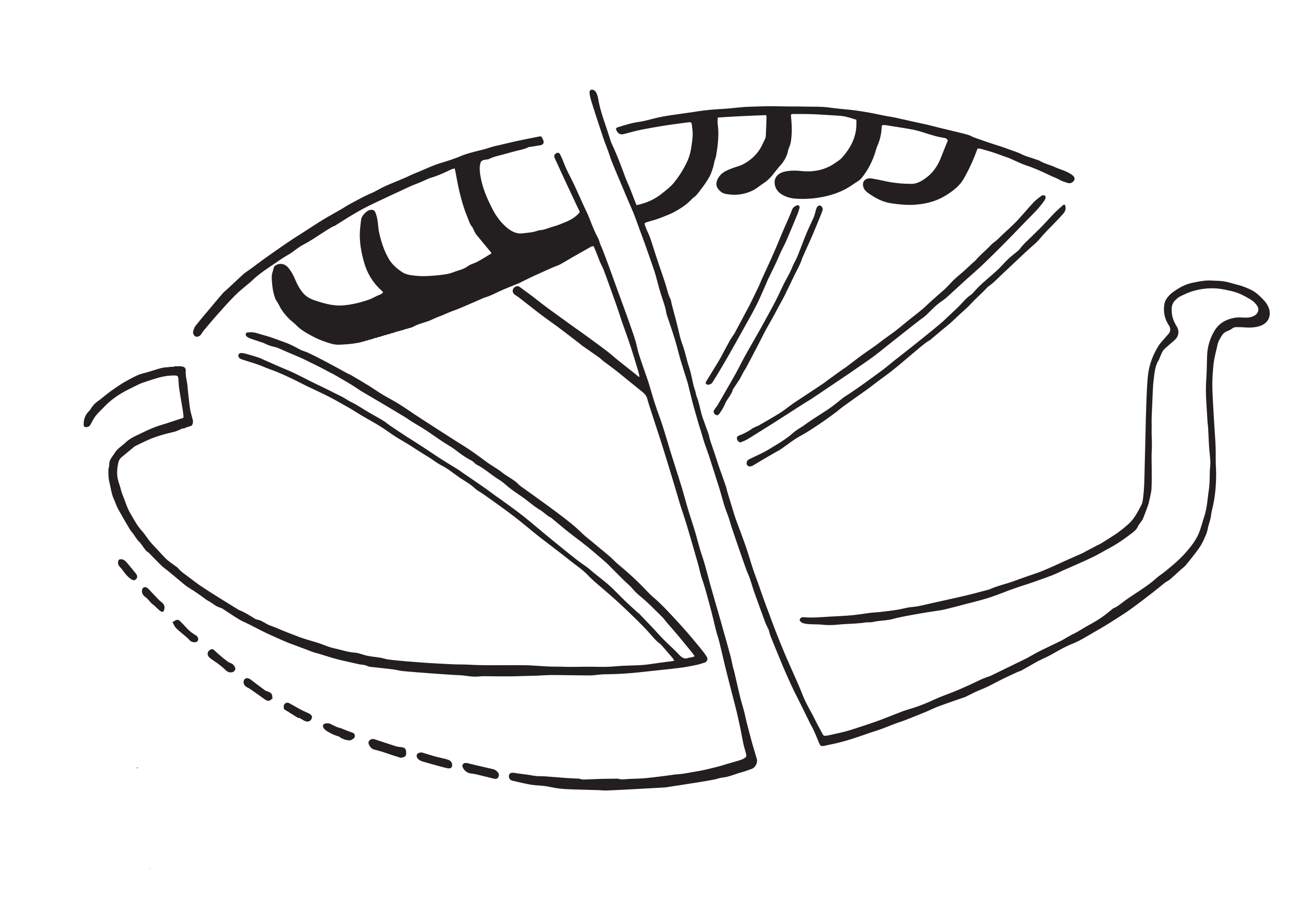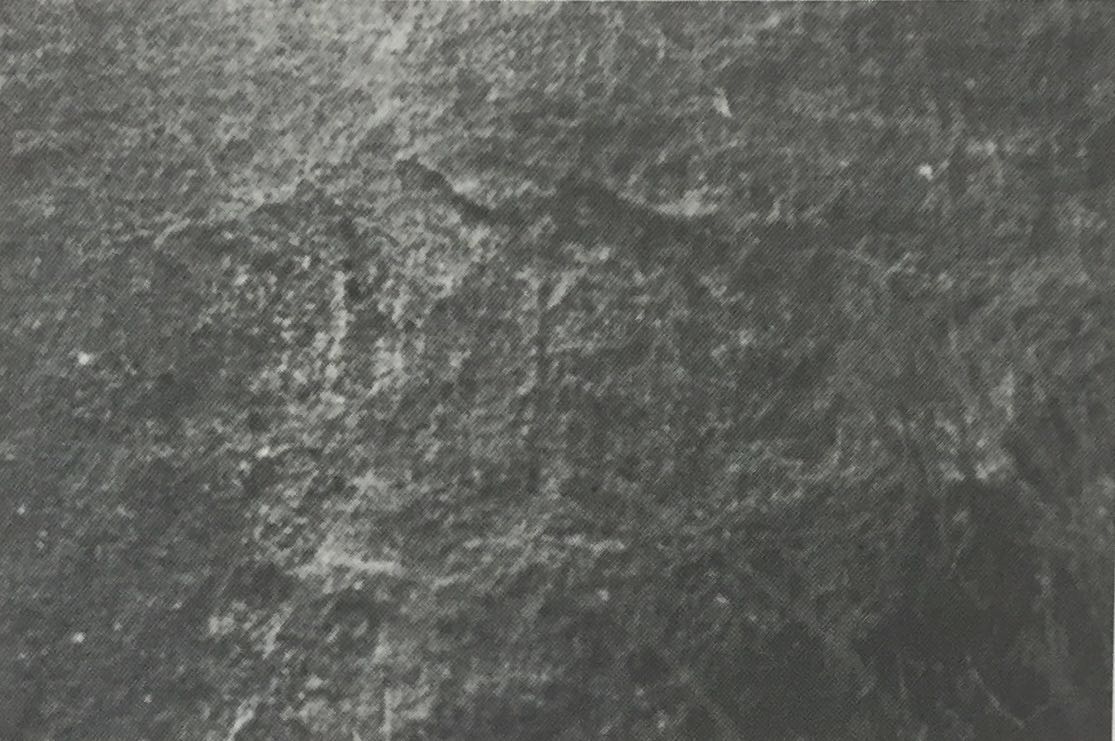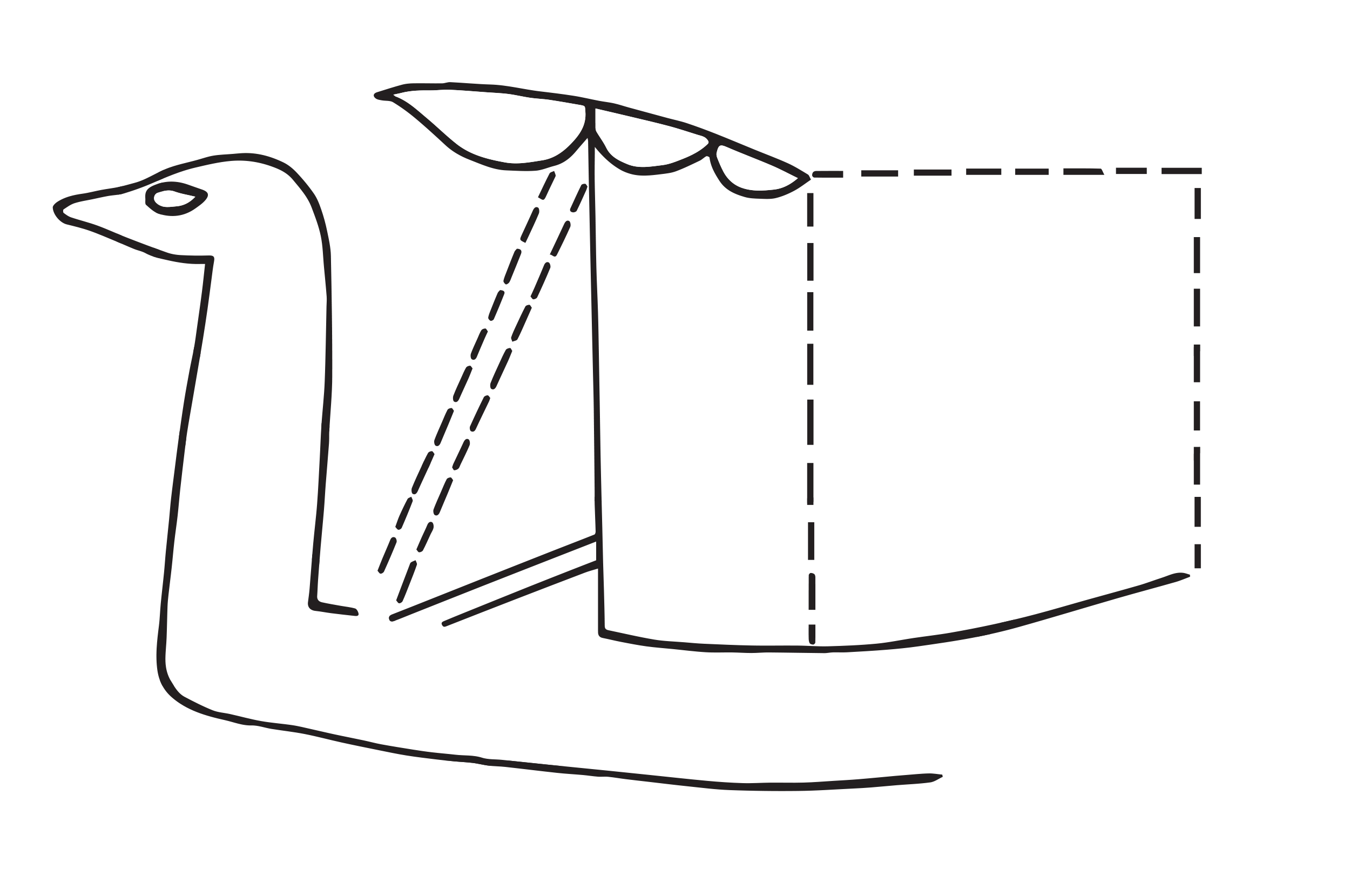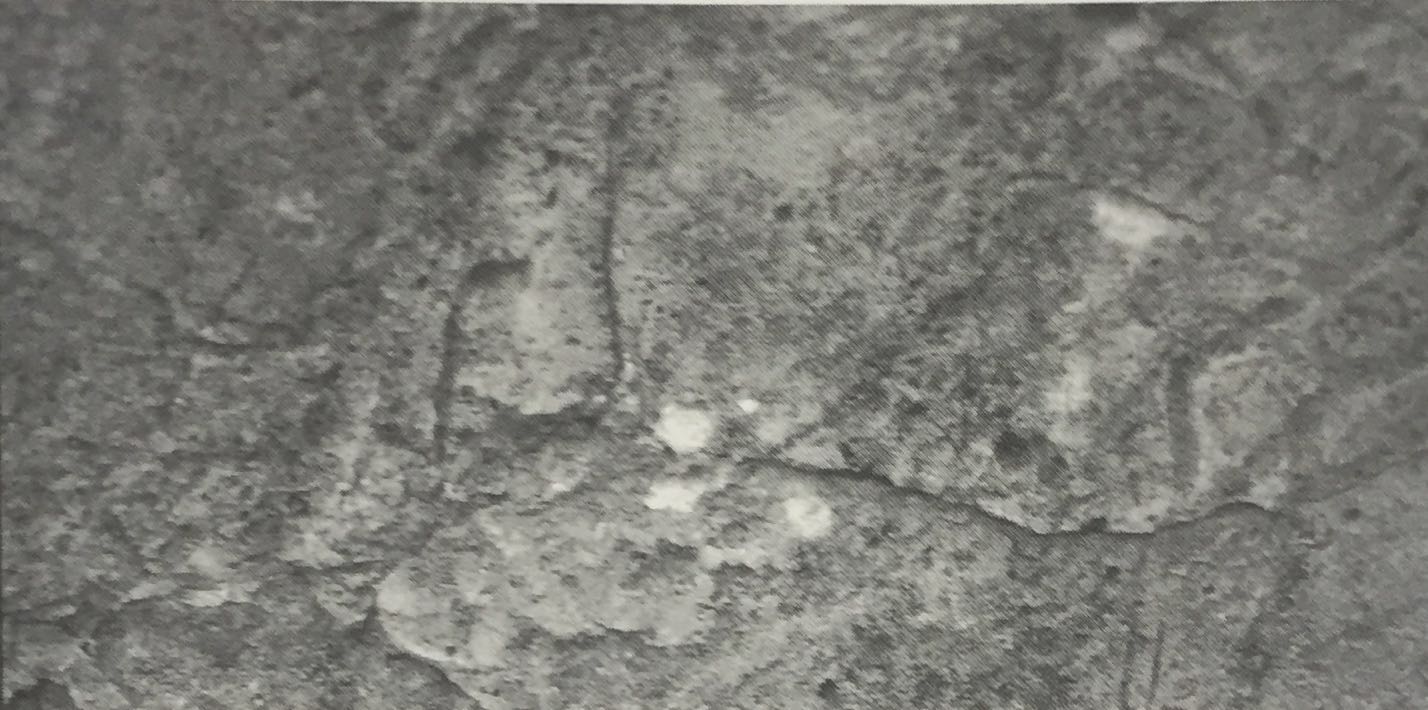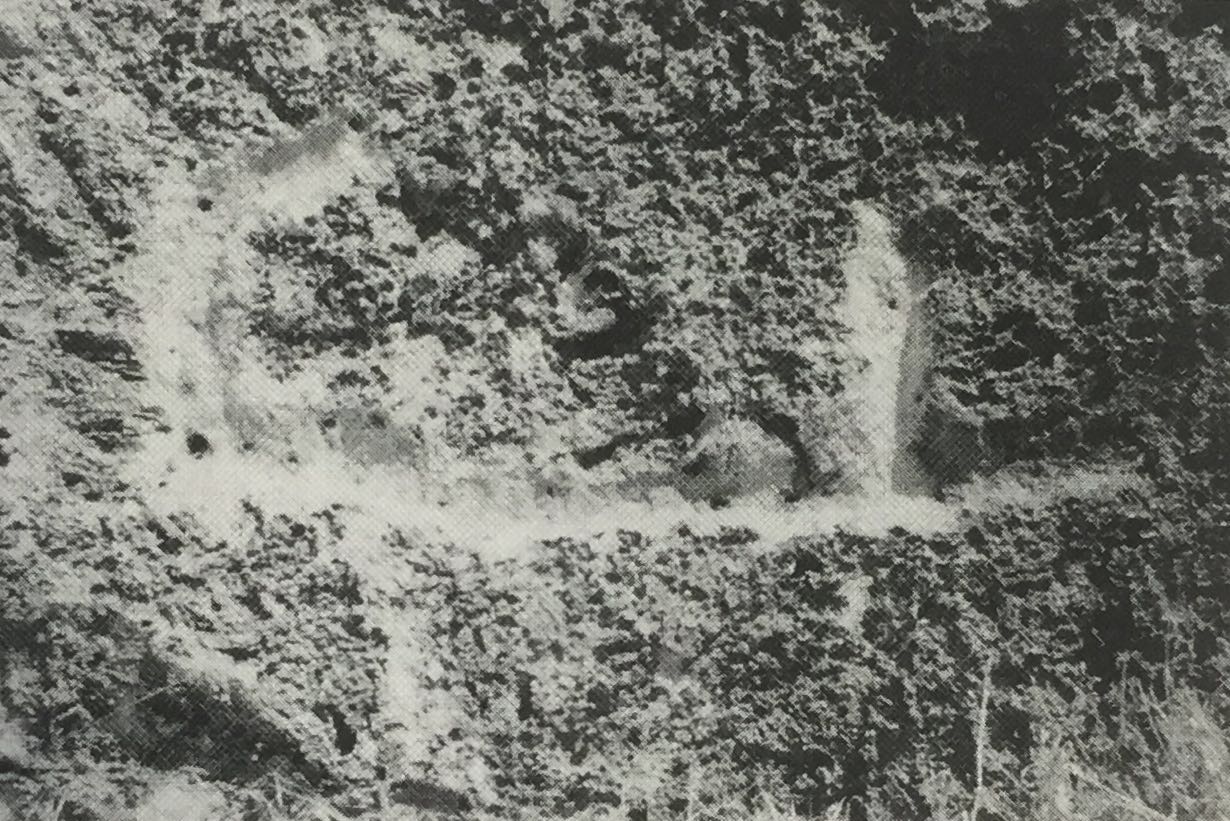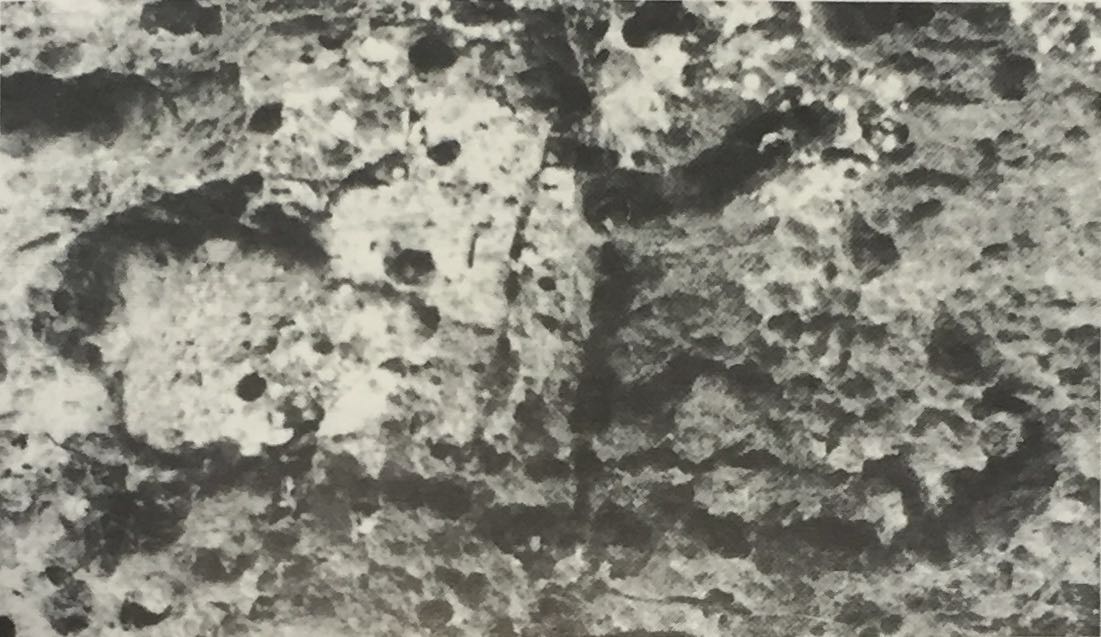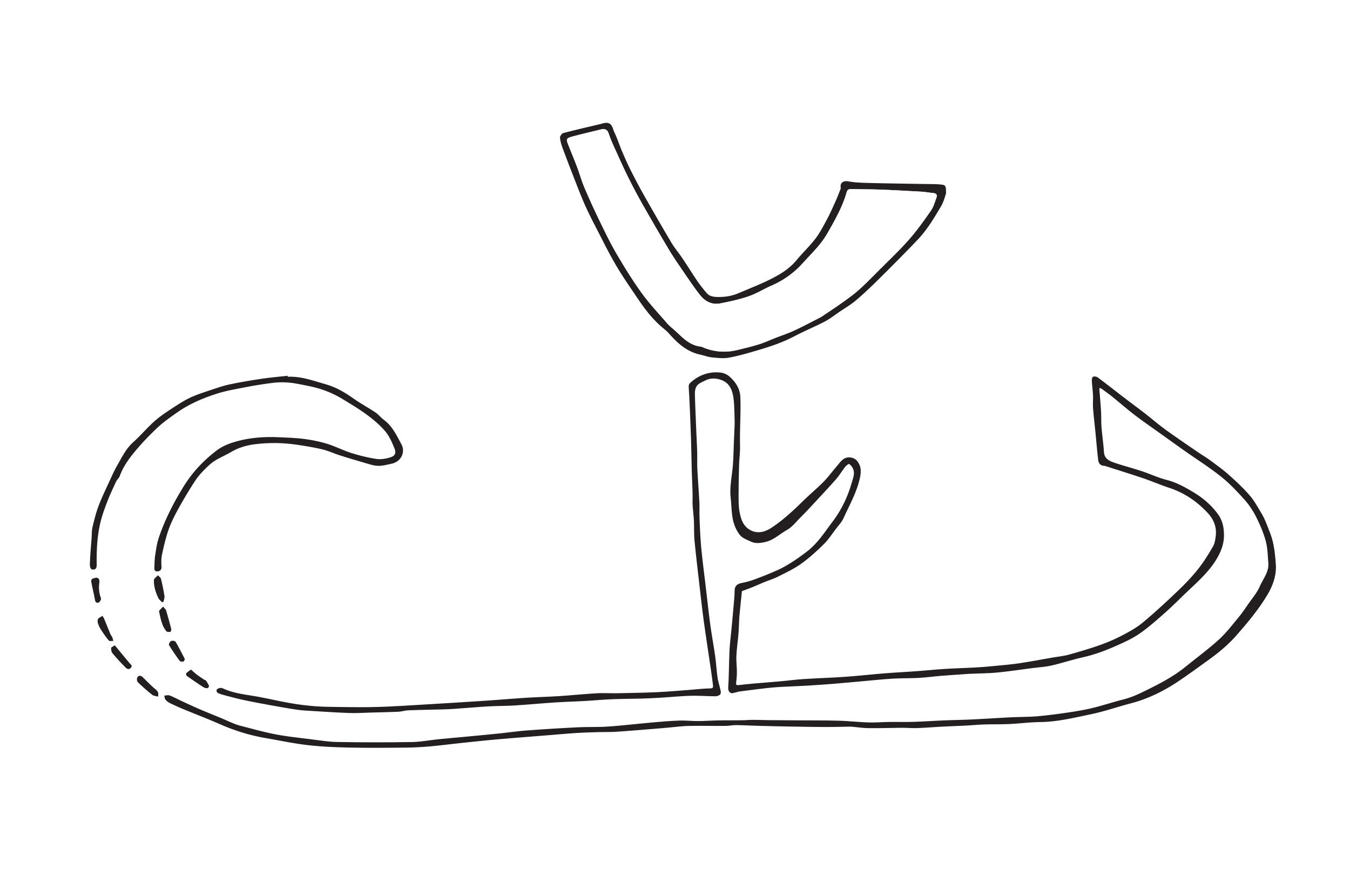L8. Nahal ha-Me'arot Aegean type ship: ship to the right, with a straight vertical stempost, a long bow projection, and a high vertical sternpost with an incurving extremity. The cutwater is a direct extension of the keel line and nearly horizontal, with only a slight upward curve. The graffito was executed with only three strokes: a single nearly straight line for the keel line and bow projection, a straight vertical incision for the stempost, and a crescentic incision for the sternpost. Despite how minimalist the representation is, it is very clearly a depiction of an Aegean-type galley, with its cutwater highlighted both in terms of the depth of the incision and its exaggerated length. Artzy singles it out as the most impressive ship graffito from the Carmel Ridge group in terms of size, position and depth of incision, although some of the other graffiti are a lot more detailed. It is located on the outcrop of rocks in Nahal ha-Me'arot, north of the 'pyramid.'
L9. Nahal ha-Me'arot "fan" type ship: ship to the right with a flat
hull and high curving extremities. Both posts have flaring ends similar
to the ship graffiti on the Akko altar which Artzy describes as "fans."
The right post has a more abrupt inward bend and is slightly less high
than the left, which based on parallels would suggest that it is the
stempost. There is a mast amidships and a crow's nest that is very
similar to the one of the Kition ships (ship 16, temple 1). A short
oblique stroke on the right side of the mast is very similar to another
one of the Kition ships (ship 1, temple 4) and thus possibly represents
part of a brace. Besides these two vessels which provide the closest
parallels, the general shape of the hull is also very similar to the
Akko altar ships.
L10. Nahal ha-Me'arot "fan" type ship 2 (?): this ship is very
difficult to discern from the photograph and has no available drawing.
Artzy notes that it has oars but not mast. From the little that is
visible on the photograph, it appears to have a crescentic hull and at
least three oars.
L11. Nahal ha-Me'arot ship with animal head device: ship to the
right with a flat hull and high curving extremities. The stempost is
straight and near vertical, ending in an animal-headed device - most
likely a bird - with a strongly recurving beak. The sternpost is
straight and vertical, bending abruptly at a straight angle at its
extremity. There is a mast amidships, with a yard and a crow's nest
above it. No sails are depicted, with the yard represented as a straight
line on the same height as the prow's bird-headed device. The crow's
nest has the additional detail of a horizontal line enclosing the lower
bowl-shaped part which is left open on some of the other graffiti. The
representation is also unusual in that a considerable length of the mast
continues above the crow's nest. The graffito is tiny, at a mere 6 cm in
length. It is located on the pyramid-shaped rock on the northern bank of
the Nahal ha-Me'arot crevis and is oriented in an east-west position,
with the prow facing west in the direction of the sea. Additional
graffiti with the same type of prow have been noted on the same rock,
which are notable for the fact that they all face in the same direction
- towards the sea.
L12. Nahal ha-Me'arot ship with a furled sail: ship to the right,
with a crescentic hull and high curving extremities. Straight vertical
stempost ending in a zoomorphic, most likely bird-headed device. The
sternpost curves gradually and terminates in a device that bends sharply
inward near parallel to the hull. There is a mast amidships, with a
crescentic yard with down curving tips and a furled sail. The rigging
consists of a brace and three brails. Size: 6 cm.
L13. Nahal Oren ship with bird-headed device: ship to the left with
a slightly crescentic hull and a high vertical stempost ending in a
bird-headed device. The stern is missing. Unlike the other graffiti with
such prow ornaments, the bird's head is shaped a lot more
naturalistically and includes an eye. There is a mast amidships, with a
crescentic yard with down curving tips and a furled sail. There is
possibly a halyard or brail, and an odd rectangular structure abutting
the yard on the right that appears much too tall and large to be an
aftercastle. The two parallel oblique strokes at the base of the mast,
if correctly identified, must indicate the mast-step system. This
feature is distinctive of Cypriot ships where it is always represented
as a triangle at the base of the mast. It is observable on the Enkomi
graffito, as well as the much later Cypro Archaic I ships. I have noted
some discrepancies between the original drawing provided by Artzy and
the photograph despite its faintness. My own drawing differs mainly in
the rendering of the furled sail which is a lot more in line with other
contemporary representations, including the other ship with a furled
sail from Nahal ha-Me'arot. The other change concerns the stempost which
is a lot straighter and less bulging at the base, as well as minor
modifications to the bird-headed device. Only a further examination of
the graffito in situ could provide further clarification. The graffito
is located on the lowest slopes of the Carmel Ridge, on the northern
bank of Nahal Oren on a solitary rock along with another graffito
supposedly similar to Artzy's "fan" type which unfortunately hasn't been
photographed. As with the Nahal ha-Me'arot ships with bird-headed
devices, the vessel faces with its prow in the direction of the sea.
Ship graffiti
L8-L13
LB IIB (13th century B.C.)
Cliffs around Nahal ha-Me'arot and Nahal Oren, Carmel Ridge
Rock carvings/graffiti on cliffs
Artzy 1994; 2001: 38-40; 2003: figs. 4-6; Wachsmann 1998: 202-203, fig. 8A.2; Wreschner 1971: pl. 47c
Rock carvings are notoriously difficult to date. Fortunately for dating purposes of the Carmel Ridge graffiti, Tel Nami was occupied during only two very specific periods, MB IIA and the end of LB IIB. During the last phases of the LBA (13th century), the site was a maritime entrepot of international scope as indicated by finds both from its open air sanctuary which reflects Canaanite, Syrian, Cypriot and Aegean cults, as well as its cemetery that displays an amalgamation of different practices. Among the impressive array of imports and luxury goods are Mycenaean LHIIIB (with some Cypriot and coastal Levantine imitations) and Cypriot vessels, but also large amounts of bronze work, gold, silver, ivory, and faience. There is furthermore clear evidence for the existence of a sanctuary and metal industries side by side, similar to temple 1 at Kition which boasts another large concentration of ship graffiti. Having a rather unremarkable anchorage - especially when compared to other nearby coastal sites - the only apparent economic advantage of the site is its location relative to the Nahal ha-Me'arot stream - a mere 3.5 km north - which connected the sea trade of the western coast of the Carmel Ridge to Megiddo, the only palatial-scale site in the vicinity. The wide riverbed afforded an easy overland route crossing the eastern kurkar ridge of the Carmel that could be completed in less than a day's hike.
The ship graffiti have been located in three different areas on the western side of the Carmel Ridge, in the Nahal ha-Me'arot and Nahal Oren areas. The largest concentration is found in the area surrounding the entrance to the Nahal ha-Me'arot which has carved a cavity in the Carmel Mountain, in particular on the northern side facing west. Artzy has argued that the cliffs of this area provided a suitable navigational landmark for mariners approaching the Carmel Ridge (and Tel Nami in particular) from the sea: "the southern cliff drops sharply in an almost straight edge while in the northern area, there is a triangular form which can best be described as a pyramid-shaped rock. The complete composition, which from afar looks much like a crevice, might have lent the name mgr (Mugar), a Semitic word meaning 'cave', to Nami."(Artzy 2003: 234). The other major location of ship graffiti is in the lower part of Nahal Oren. The total number of ship graffiti is difficult to assess based on Artzy's report, but there is no question that there are a lot more than the seven mentioned in her publication, only six of which have been illustrated. At least three additional bird-headed prows are observable on a photograph next to the tiny ship (L11). The majority of them are said to belong to Artzy's "fan" type, but there is also at least one with a distinctly Aegean form, and many more with bird-headed device similar to the ships of the sea people displayed at Medinet Habu.
Much like the multicultural profile of Tel Nami, this collection of ship graffiti displays at least three different types of ships. It is notable that a number of them were incised with their prows facing the sea, and were thus possibly made prior to departure to ensure a safe journey. Some of the ships have close parallels with roughly contemporaneous graffiti from Kition and Akko, while others are close to the type belonging to the sea people on the Medinet Habu relief.
Artzy, M. 1994. “On boats, on Rocks and on ‘Nomads of the Sea,’” CMS News 21.
―――. 2001. “The Medinet Habu Boat Depictions: can we trust Ramses Ill?” in H. Tzalas (ed.) Tropis VI: Sixth International Symposium on Ship Construction in Antiquity, Lamia, 28, 29, 30 August 1996. Athens: Hellenic Institute for the Preservation of Nautical Tradition, pp. 35-44.
―――. 2003. “Mariners and their Boats at the end of the Late Bronze and the beginning of the Iron Age in the Eastern Mediterranean,” Tel Aviv 30: 232-246.
Wachsmann, S. 1998. Seagoing Ships & Seamanship in the Bronze Age Levant. College Station, TX: Texas A&M University Press.
Wreschner, E. 1971. “Prehistoric Rock-Engravings in Hanal ha-Me’arot, Mount Carmel,” IEJ 21: 217-18, pls. 46-47.


